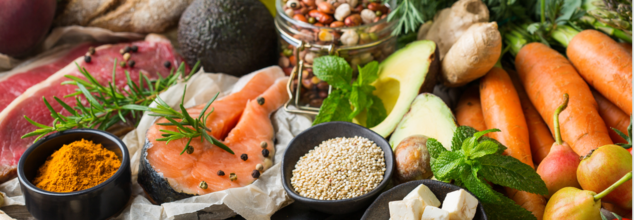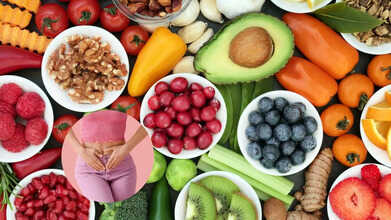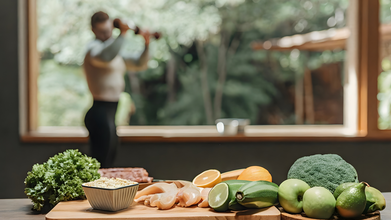- Health Conditions A-Z
- Health & Wellness
- Nutrition
- Fitness
- Health News
- Ayurveda
- Videos
- Medicine A-Z
- Parenting
- Web Stories
High-Calorie Foods To Help You Gain Weight Safely And Quickly

Image Credit: Canva
For some, gaining weight is as hard as losing it. If you're having a tough time adding pounds to your body, it's crucial to do so in a healthy and sustainable manner. This guide discusses nutrient-rich foods and techniques for healthy weight gain so that you're not only putting on weight but also ensuring you're maintaining overall health.
Weight gain is the intake of more calories than your body burns in a day. The calorie surplus supports muscle growth, increases bone density, and adds fat to your frame. However, the kind of weight you gain—whether it is muscle or fat—is determined by your diet and activity levels.
It includes genetic factors, age, hormones, health, and exercise routine that can significantly contribute to the gaining of weight quickly. The balance of nutrition combined with strength training is necessary to achieve desired outcomes.
How to Build a Calorie Surplus
For weight gain, you have to change your calorie intake:
Determine Your Baseline
Calculate the calories you would require to support your current weight.
Add Calories Gradually
Increase your daily calories by 500–1,000 calories at a time. This slow method allows for a steady, healthy weight gain.
Eat Nutrient-Dense Foods
Eliminate junk foods. Replace with calorie-dense, nutrient-dense foods for optimal health.
Foods That Help Gain Healthy Weight
1. Protein Smoothies
Protein smoothies are a convenient way to increase your calorie and protein intake.
- Blend banana, chocolate whey protein, and peanut butter with milk.
- Combine fresh berries, Greek yogurt, and vanilla whey protein.
- Use spinach, avocado, banana, and pineapple for a nutrient boost.
These shakes are customizable and pack a calorie punch, making them ideal for weight gain.
2. Dairy Milk
Milk is a perfectly balanced mixture of proteins, fats, and carbohydrates. Rich in calcium and vitamins, it is a staple food for decades, used to gain weight and develop muscles. Taking it regularly after exercise increases the growth of muscle.
3. Salmon and Oily Fish
Salmon is rich in high-quality protein and omega-3 fatty acids, which is a need for muscle repair and overall health. A single fillet gives about 155 calories and 22 grams of protein. Grill, bake, or poach salmon as a great addition to your dishes.
4. Protein Supplements
Whey protein supplements are very popular among athletes wishing to gain body mass. When used with strength training, they can help gain weight effectively. Choose products that contain whey, soy, or pea proteins.
5. Dried Fruits
Dried fruits, for example, contain raisins, dates, and apricots. They contain calories and full of fiber, antioxidants, and vitamins. Couple them with nuts or Greek yogurt for a snack that's highly calorie-rich.
6. Avocados
Avocados are rich in calories and filled with healthy fats called monounsaturated fats. One large avocado contains 365 calories and 30 grams of fat. Dip them in salads or guacamole.
7. Nuts and Nut Butter
Nuts like almonds and walnuts are rich in calories and healthy fats. Nut butter, such as peanut or almond butter, can be added to smoothies, oatmeal, or toast for an extra calorie boost.
8. Potatoes and Complex Carbohydrates
Potatoes, quinoa, oats, and other complex carbs provide sustained energy and essential nutrients. Roast sweet potatoes or make quinoa salads to incorporate these into your diet.
9. Cheese
The calorie-rich food item cheese can be combined with almost any food. One ounce of cheddar cheese contains 110 calories and 7 grams of protein. It is a good food for weight gain, but be sure not to overdo this, because too much saturated fat isn't good.
Tips for Gaining Weight
- Eat five or six small meals a day.
- Use calorie-dense add-ons such as olive oil, seeds, and dried fruit during meals.
- Hydration properly helps in digesting food items and absorbing their nutrients.
- Combine weight lifting with diet in order to increase muscle mass without gaining fat.
Weight gain is achieved by the right balance of calorie intake and nutrient-dense food choices. You can add these foods to your diet and incorporate practical tips into your plan for safe and effective weight gain. Always consult a healthcare professional or dietitian to tailor your plan to your specific needs. With persistence and the right approach, you can achieve the healthy weight gain you are aiming for.
Your Menstrual Cycle Affects How You Eat—Here’s What to Eat During Each Phase

Credits: Canva
With growing awareness of how the female body changes each month, and the help of apps that make tracking easier, more women are beginning to understand how to live in sync with their cycles. According to Dr. Uma Shankar Sharma, Medical-In-Charge at Kailash Institute of Naturopathy, Ayurveda, and Yoga, what you eat during each phase of your menstrual cycle has a major impact on your hormones, energy, and mood.
What Are the Different Phases of the Menstrual Cycle?
Though biology books often describe a 28-day cycle, in reality, most women fall anywhere between 23 and 35 days. Within that span, the body passes through four phases: menstrual, follicular, ovulatory, and luteal. Each phase involves different hormonal changes and physical shifts that influence how you feel and function.
Four Phases of the Menstrual Cycle
The menstrual cycle begins with the menstrual phase, when the uterine lining is shed as bleeding. Next comes the follicular phase, when the body prepares an egg for release. During the ovulatory phase, a mature egg is released, and in the luteal phase, the uterus thickens in anticipation of pregnancy. If conception does not occur, the cycle restarts, as per Cleveland Clinic.
What to Eat During Every Phase of Your Menstrual Cycle
Food choices play a key role in maintaining hormonal balance, energy, and overall wellness. Dr. Sharma explains that Ayurveda recommends eating according to the body’s changing doshas, Vata, Pitta, and Kapha, throughout the month. Aligning your diet with these shifts can ease cramps, bloating, and fatigue, while helping restore nutrients lost during menstruation.
1. Menstrual Phase (Days 1–4)
At the start of your period, Vata dosha is heightened, and your body needs warmth and comfort. Dr Sharma suggests choosing simple, nourishing meals like steamed khichdi (made with moong dal and rice), warm porridge with ghee, and lightly cooked leafy greens. Gentle spices such as cumin, coriander, fennel, and ginger aid digestion, while ghee or sesame oil supports nutrient absorption. Avoid cold, raw, or fried foods, which can worsen pain and slow digestion. A warm cup of ginger tea can help soothe cramps and ease bloating.
2. Follicular or Postmenstrual Phase (Days 5–14)
As your energy returns, Kapha dosha rises. Focus on lighter, fresh meals that recharge your system, think fresh fruit, steamed vegetables, whole grains like millet, barley, or quinoa, and soft-cooked lentils. Dr Sharma says, “Soaked nuts and seeds provide essential minerals. Mild spices like turmeric, coriander, and ginger help keep digestion active and support nutrient absorption during this rejuvenating stage.”
3. Ovulatory Phase (Days 14–17)
During ovulation, Pitta dosha dominates, and your body functions at its most active. Cooling and hydrating foods are best during this time. Dr Sharma suggests eating fresh fruits such as watermelon and cucumber, drinking coconut water or diluted juices, and including sprouts and plant-based proteins like tofu or paneer. Avoid spicy, oily, or sour foods that can increase internal heat or irritate digestion.
4. Luteal/Pre-Menstrual Phase (Days 18–28)
As Pitta remains strong and Vata begins to rise again, your body benefits from grounding, nourishing meals that help calm premenstrual discomfort. Complex carbohydrates such as sweet potato, squash, oats, and cooked greens can support stable energy levels. Foods rich in magnesium, like bananas, seeds, nuts, and dark chocolate, can help ease cramps, bloating, and mood swings. Staying hydrated, sipping herbal teas, and including healthy fats throughout the month help maintain a steady, balanced cycle.
Can You Train Yourself To Eat Less For Your Metabolism? Neurologist Shares 10 Lifestyle Changes That Can Help

(Credit-Canva)
When it comes to eating, it is very easy to overdo it and cause problems for your health. Eating too much food is not just about gaining weight, but it can cause lot of issues for your metabolism as well as cause harmful reactions. According to the MD Anderson Cancer Center, overeating can cause a reaction known as heartburn, where the acid that breaks down your food gets pushed up towards your esophagus. Other problems that may arise could be bloating, organ strain, abdominal discomfort, etc.
All of these issues could be avoided if one controls one's eating habits. However, can you change the way you eat and train your body to avoid overeating? According to Dr Sudhir Kumar, Hyderabad-based neurologist, you can.
10 Habits That Can Help You Avoid Overeating
In a recent post on social media platform X, Dr Sudhir listed 10 ways one can teach one's body to avoid overeating and protecting their metabolism.
Tweak Your Eating Space
You can trick your brain into eating less by changing your environment. Try using smaller plates and bowls—it makes smaller portions look more satisfying. Keep food out of sight; if you don't see it, you won't think about snacking impulsively. Also, keep serving dishes in the kitchen, not on the dinner table, to make it harder to grab second helpings.
Slow Down How You Eat
Give your brain time to catch up with your stomach. Eat slowly and chew your food well. Make a point of putting your fork or spoon down between bites. It takes your brain about 15 to 20 minutes to register that you're full, so slowing down gives this "fullness signal" time to register, helping you eat less overall.
Handle Social Eating Smartly
When you're eating with friends or family, you tend to eat more because meals last longer. To manage this, serve yourself a fixed portion before you sit down. Then, focus on the conversation instead of reaching for more food. If you stay at the table for a long time, sip on water instead of continuing to eat.
Build Your Meal Strategically
Eat your food in a specific order to help manage your blood sugar and keep you feeling full longer. Start with vegetables or salad, then move to protein, and finish with carbohydrates. This order prevents rapid sugar spikes and avoids the quick hunger that comes after eating simple carbs like bread or sweets first.
Prioritize Filling Foods
Make sure every meal includes a source of protein like eggs, pulses, yogurt, or fish, and fibre from vegetables, whole grains, and fruits. Both protein and fibre are excellent at increasing the feeling of fullness, which naturally cuts down your total calorie intake. Try to limit high-calorie, non-filling items like refined carbs and processed snacks.
Don't Ignore Sleep and Stress
Poor sleep and high stress directly affect your hunger. Aim for 7–8 hours of sleep nightly, because lack of sleep increases the hormone that makes you hungry, called ghrelin, and lowers the hormone that tells you that you're full which is called leptin. Manage stress with things like walking, deep breathing, or meditation. Chronic stress often leads to emotional eating and intense cravings.
Move Your Body More
Moving doesn't just mean a full workout. Take a short walk (10–15 minutes) after meals; this is a great way to stabilize your blood sugar and help digestion. Avoid sitting still for hours; taking short standing breaks and small movements throughout the day actually improves how your body uses insulin.
Use Water to Your Advantage
Drinking water can subtly help you eat less. Drink a glass of water before meals; this can modestly reduce how much food you eat. Always avoid sugary drinks and juices, as they add lots of calories without making you feel full.
Focus Only on Eating
Sit down and eat without screens, no TV, phone, or laptop. This helps you pay attention to your body's signals of hunger and fullness. Before and after you eat, quickly rate your hunger on a scale where 1 is starving, and 10 is painfully full. Aim to stop when you feel comfortably satisfied which is around a 7.
Plan Your Portions
Don't eat snacks straight out of a large bag; pre-portion them into small containers. Use smaller utensils, like a teaspoon for desserts, to naturally slow down your eating speed. Finally, don't skip meals! Getting extremely hungry almost always causes you to overeat later in the day.
Diet, Not Lack Of Exercise Is The Real Reason For Rise In Obesity, According To Study

Credits: Canva
The debate between what is more important or the driving factor behind the rising cases of obesity may be solved now. Thanks to the new research led by over 50 institutions across 19 countries that revealed it is diet, or in simpler words, the calorie consumption and not the lack of physical activity that is a dominant factor driving obesity.
The study is published in the Proceedings of the National Academy of Sciences (PNAS). The study is more so important because it challenges the belief that sedentary lifestyle is the primary cause of driving the obesity rates high.
What Did The Study Find?
The study found that higher calorie intake actually plays a much larger role in obesity than reduced physical activity. Despite decades of research into the causes of the obesity crisis, the relative importance of diet versus physical activity has remained uncertain,” said Herman Pontzer, professor of evolutionary anthropology and global health at Duke University, and one of the study’s authors. “The IAEA’s Doubly Labelled Water Database has allowed us to finally test these ideas on a global scale and bring clarity to this major public health challenge.”
What Is IAEA? Why Does It Matter?
IAEA stands for the International Atomic Energy Agency. The research recently published used IAEA's Doubly Labelled Water (DLW) Database, which is one of the world's largest collections of energy expenditure data. The dataset was able to provide the researchers a look into the balance between energy intake and energy output across the populations and economies.
Is Global Obesity On The Rise?
In 2022, nearly 1 in 8 people worldwide were living with obesity. This is a number that has doubled more in adults and quadrupled among adolescents in the past three decades. Obesity also increases risk of many chronic illnesses and diseases, including diabetes, cardiovascular disease, and also certain cancers.
While industrialized societies see soaring obesity rates, traditional and farming communities experience much lower levels of obesity, a contrast often attributed to more physically demanding lifestyles.
This is where this recent study plays a big role. The study found that this assumption does not fully hold true. Even though physical activity across population, or the energy expenditure, that is the total calories burned daily is not significantly lower in industrialized population, their body size is larger. So, if not the energy output, then what is the reason? The answer lies in the diet.
How Was The Study Conducted?
The researchers analyzed data from 4,213 adults aged 18 to 60, representing 34 populations across six continents. Participants included hunter-gatherers, farmers, and urban dwellers. Using the DLW technique, the researchers measured total energy expenditure (TEE), basal energy expenditure (BEE), and active energy expenditure (AEE).
Although people in industrialized nations had higher total energy expenditures due to their larger body sizes, their activity levels, when adjusted for body size, were only slightly lower than those in traditional societies. This slight difference explained less than 10% of the overall increase in body mass index (BMI) and fat percentage. The main driver was higher calorie intake, often from ultra-processed, high-fat, and high-sugar foods.
Findings: Diet Matters More
“For public health professionals, these findings emphasize that improving diet quality, and reducing consumption of high-calorie, ultra-processed foods, may be far more effective than focusing solely on physical activity,” explained Cornelia Loechl, Head of Nutritional and Health-related Environmental Studies at the IAEA. “It underscores how impactful scientific data can guide better health policies.”
Thomas M. Holland, a physician-scientist at RUSH University in Chicago, who was not involved in the study, added: “This research reminds us that while exercise remains essential for overall health, obesity appears to be more closely tied to what and how much we eat. Economic development offers access to more food, but also increases exposure to obesogenic diets.”
© 2024 Bennett, Coleman & Company Limited

